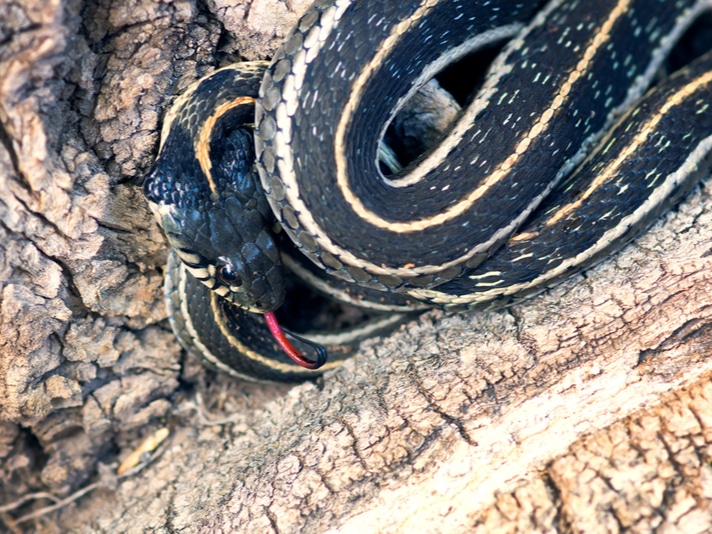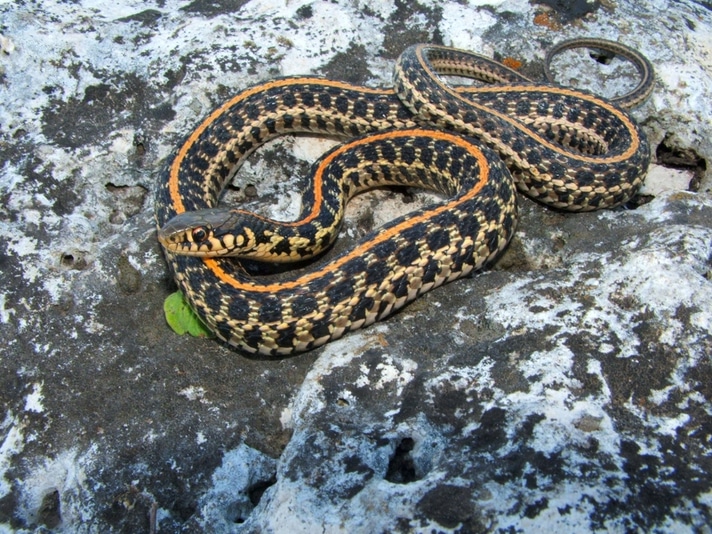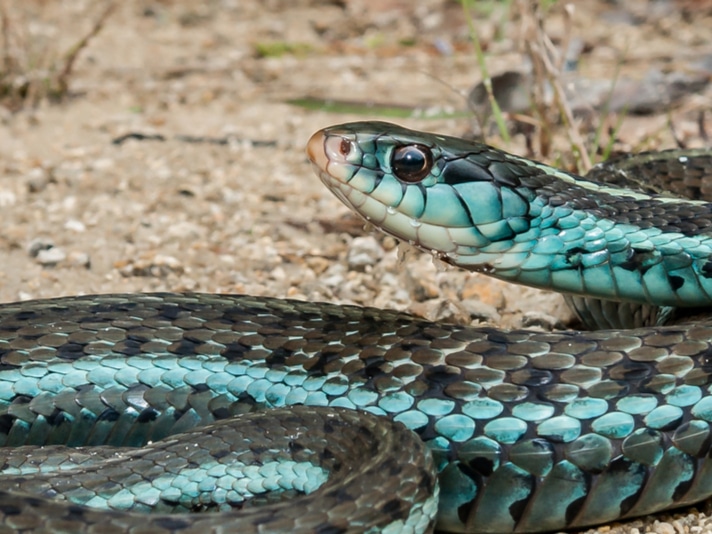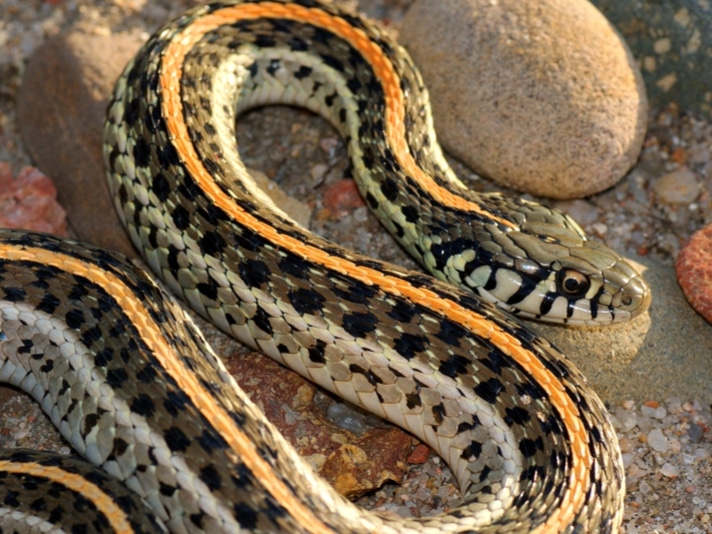Everything you need to know to successfully keep the garter snake.
Growing up in southeastern Michigan gave me an early love of Thamnophis. Found there in great abundance – at least at that time – are eastern and Butler’s gartersnakes.
Garter snakes are small by colubrid standards. Females average anywhere from 30 to 36 inches in length; males average 16 to 24 inches. The largest Thamnophis species is the giant gartersnake (T. couchi gigas), found in central California, which can reach a length of 4 feet or more. The smallest is the short-headed gartersnake (T. brachystoma), averaging 16 inches.
There are approximately 75 species/subspecies of gartersnakes that are found from the southern tip of Alaska, throughout most of Canada and the United States on into Mexico and Central America. Habitats vary from species to species. Swamps, marshes, prairies, open fields, forests, deserts, mountains are all habitats that particular species of garters prefer. The eastern garter (T. sirtalis sirtalis) has the largest range of any Thamnophis species; the short-headed garter has the smallest range, located predominately in northwest Pennsylvania on into southwest New York.
Garter snakes are small by colubrid standards. Females average anywhere from 30 to 36 inches in length; males average 16 to 24 inches
Females bear their young live, and litters average 25 babies. Litters of more than 80 neonates have been documented. Life expectancy for garters average 10 years. A wandering garter reportedly lived 17 years – very ancient by most Thamnophis standards. Most gartersnakes are docile by nature. They may attempt to bite if you come across them in the wild, but they generally calm down to make good pets. Consistent handling often calms them as they tend to be fairly active colubrids.
Eastern Garters
Eastern garters (T. s. sirtalis) range from southern Canada to the Gulf of Mexico and west to Minnesota and eastern Texas. They are often found close to water and in a variety of habitats, including mountains, swamps, marshes, open fields, woodlands and even urban areas.
Adult females average 30 to 36 inches in length and weigh 8.8 ounces; males are 16 to 24 inches long, depending on their locality. The largest gartersnake I ever owned was a Florida eastern female. She measured 42 inches in length and weighed more than 21 ounces.
Coloration and patterns vary immensely for this species. Stripes differ in coloration from green to yellow and may even be bluish. Body colors include red, brown, black, green, blue and olive.
Eastern garters consume frogs, toads, salamanders, earthworms, fish and rodents.
Red-Sided Garters
The red-sided garter’s (T. s. parietalis) range is nearly as vast as the eastern’s. They occur north into the very southern tip of Alaska, south to Oklahoma, east to Iowa and Minnesota and west to Montana and Wyoming. They prefer open fields, meadows and waterways. Out west they can be found high up into the mountains. Their diet consists of frogs, toads, fish and rodents.

Thamnophis eques megalops By IrinaK/Shutterstock
Females typically measure 30 to 36 inches, while males are 16 to 24 inches in length. Varying degrees of red, yellow, black and orange make this one of the prettiest Thamnophis species. Variations of the red coloration occur, as well. Brick, fire engine, maroon and chestnut are all shades of red that T. s. parietalis may exhibit. Kansas is well-known among Thamnophis herpers for having the prettiest red-sideds of all the localities where they are found.
The Garter Snake: A North American Icon
Plains Garters
Plains garters (T. radix and T. haydeni) are very common throughout their range. They exist in the central Canadian provinces west to Montana, Wyoming and Colorado, and east to Iowa, Minnesota and south into Oklahoma and extreme northeastern New Mexico. Their habitat primarily consists of meadows and open fields, close to waterways and also urban areas. They eat earthworms, frogs, toads and rodents.

Plains garter snake Matt Jeppson/Shutterstock
Plains garters are primarily black with a bright yellow and/or orange stripe. Plains have double alternating rows of black spots that differentiate them from other Thamnophis species. Adult females range from 30 to 36 inches in length; adult males are 16 to 24 inches. One of my adult females had 61 babies three years ago, the largest litter I’ve had to date.
Wandering Garters
Wandering garters (T. elegans vagrans) are frequently seen throughout their range, which runs north into British Columbia, south into most of New Mexico and Arizona, west into eastern California on up into central and eastern Oregon and Washington. The eastern portion of their range extends into most of Montana, the southwestern tip of South Dakota, northwestern tip of Nebraska and most of Colorado.
Wandering garter coloration differs from locality to locality. Colors include brownish green, brown and gray. Their bellies are often mottled with black, as well. Wandering babies are large by Thamnophis standards, averaging 7 to 8 inches in length at birth. (Most garter babies are in the 4- to 5-inch range.) Adult females measure 30 to 36 inches – typical size for Thamnophis – and males are 16 to 24 inches in length.
From my experience in breeding this species, they don’t fatten up as other garter species do. Females tend to be leaner than other species that I have kept. They have one of the most varied diets of any Thamnophis species, too, feeding upon lizards, frogs, toads, fish, salamanders, earthworms, ground-nesting fledgling birds and rodents. Wandering garters are one of the few cannibalistic Thamnophis species. I have heard an account of a wild-caught individual regurgitating a rubber boa!
Blue-Striped Garters
Found in a very limited range in western Florida, blue-striped garters (T. sirtalis similis) occur in Wakulla County south to the Withlacoochee River. Their preferred habitat is marshes and pinewoods of northwestern Florida. Diet consists of frogs, toads, fish and rodents.

Bluestripe garter snake Photo by Jay Ondreicka/Shutterstock
Coloration varies from sky to navy to dark blue. The dorsal stripe is either a yellowish golden or a tannish color. White speckles are evident throughout the body, as well. At birth they don’t show these colors, instead looking like normal Florida eastern garters. However, as they grow, their colors become more distinguishable. This species is often confused with the Florida eastern garter due to some normal easterns that have a high degree of blue in their coloration.
In my collection, this species tends to be smaller than other garters. Adult females are typically 24 to 30 inches, and adult males are 16 to 20 inches in length.
Reproduction
Most Gartersnake species mate in the spring. Males emerge first from hibernation, congregate outside of the dens and wait for the females. Upon emerging, females give off pheromones, which lets the males know they are in breeding condition. Once females successfully copulate, the pheromone scent ceases, males lose interest and look for females that have yet to breed.
Studies have been done on garters from the famous Manitoba, Canada breeding grounds. At this site, males outnumber females by the hundreds, and males have developed an unusual adaptation for these lopsided numbers. Males have been documented producing the same pheromones that females produce, thus being called “she-males.” Other males attempt to breed with these males the same as they would females.
Manitoba is also world-renowned for the gartersnake “breeding balls.” Numerous males combine with a single female and literally create a rolling mass of snakes, much like a ball. I once saw a squirming mass of 20 Butler’s garters (T. butleri) on the inside of a tire liner. This more than likely was a breeding group.
Young males can breed in as little as nine months, females generally in 21 months. Maturity varies from species to species, but on average, mature males should be in the 13- to 14-inch range to successfully breed. Females should be 20 to 24 inches with a decent amount of girth. If the female is long enough but lacks girth, do not breed her. Attempting to breed her will more than likely be unsuccessful and can cause stress, potentially decreasing her life expectancy.
Simple Enclosures
I like to keep it simple. Caging for garters is relatively easy, based on their sizes. For baby snakes, a 10-gallon tank is the perfect size. Normal sized adult males and females can be housed in 29-gallon terrariums. For larger females (longer than 36 inches), a 50 gallon is an adequate size. Make sure the tops fit tightly; garters are well known for being escape artists.
Items that are beneficial for garter cages are hide boxes, a heavy-duty water bowl, an undertank heat mat and rocks. The heat mat should be placed at one end of the enclosure so the snake has the option of going to the warm, heated end or to the cool, unheated end. Hide boxes should be placed over both the heat mat and the opposite end of the cage. Jagged edged rocks help to facilitate shedding and can be used to decorate. Place the water bowl on the cool, unheated end to avoid causing excessive moisture buildup in the cage.
Branches are not necessary as garters are ground-dwelling snakes; however, they can be used for aesthetics. Numerous types of substrates can be used – Astroturf and newspaper are two of the easiest. As snakes defecate, remove the newspaper or Astroturf, and clean out the enclosure.
For my collection, I use Carefresh and Tekfresh. These products are both wood byproducts that are pliable and come in pulp form. When the snakes defecate, the feces clump up and are easy to remove. For people with a large collection, I highly recommend these products. Avoid using topsoil, dirt, sand and gravel as substrates.
The cage should be kept dry. Humidity and moisture can lead to snakes developing skin blisters and other health problems. Temperatures are best kept at 85 degrees Fahrenheit on the heated end and 78 on the cooler end of the enclosure.
Garter Diet
Garter snakes swallow living prey as opposed to constricting it first. Diets vary from species to species. Fish, fish eggs, lizards, frogs, toads, salamanders, earthworms, leeches, carrion, rodents and birds are all documented prey items of various gartersnake species. A few Thamnophis are cannibalistic, such as the wandering garter and the western terrestrial garter.
There are two schools of thought when it comes to the gartersnake’s captive diet. One is to vary the diet, the other is to offer only rodents. Examples of a varied diet are to offer feeder fish one meal, worms the next and, on occasion, a frog, toad or pinky.
I prefer feeding an all-rodent diet. I feed my adult males once a week. (When males are breeding, they often won’t eat; they’re more interested in mating than eating.) Babies and subadults should be fed every four to five days, due to their high metabolism. My entire collection of garters (125+) feeds on unscented frozen/thawed mice.
Adults can be fed once a week to every 10 days. Gravid females should be fed every four days. Once gravid females stop feeding, they generally give birth a couple of days to a month later. After they’ve given birth, go back to feeding them once a week. They almost always eat the day after the babies are born.
Appropriate food items for neonate garters include feeder fish (guppies or rosy feeders work well) or earthworms. To switch babies over to mice, cut up a pinky and mix it in with their food bowl. Over time, decrease the number of fish or worms being offered and increase the pinkies until the snakes are eating unscented pinkies. Some switch over easily, others require a bit of perseverance. Try feeding unscented on the first try. If luck is on your side, the snake will take it willingly.
Vitamin and calcium supplements are very important if you’re offering fish, worms or frogs, but not necessary if your snake is feeding solely on rodents, which provide a balanced diet for snakes. The vitamins help give the snake a well-balanced diet they would otherwise be missing.
Plains Garter Morphs
Garter morphs are becoming increasingly popular. I developed two strains of snows from Plains garters: the Iowa snow in 1999 and the Nebraska snow in 2000. The Iowa snow is born high pink; however, most tend to lose that coloration into adulthood. Adults vary from a yellowish to pearly white color with a very faint yellow stripe and red eyes. The Nebraska snow is more of a lavender/pink color with a yellowish/white dorsal stripe and dark red eyes.
Two albino Plains gartersnake morphs maintained in my collection are the Iowa and Nebraska albinos. The Iowa albino is predominately a white albino with lavender stripes and pink eyes. The Nebraska albino is a wheat-straw yellow with dark red eyes. These two strains are not compatible with one another.
The anerythristic Plains is an overall dark morph, bluish black with a blue/gray dorsal stripe. This strain was found in both Iowa and Illinois and proved to be compatible with one another.
The red albino Plains, amazingly enough, was discovered when an adult snake was found in front of an apartment complex in urban Iowa! This morph is compatible with the Iowa albino strain.
One of the biggest surprises I produced in 2001 was the “Christmas albino.” This morph possesses a high degree of orange, white and lavender, all intermixed. The babies from this lineage start out looking like normal albinos, but as they mature, they gain more coloration. One Christmas albino female produced what I call the Super Christmas albino. This morph’s colors are almost neon in appearance, with extreme amount of intense orange, red, yellow, lanvander and white. The Christmas trait proved to be genetic, but the Super phase has yet to be. I plan on breeding this morph in the spring of 2004.
Other Morphs
Eastern garter morphs are as colorful as the Plains. Naturally occurring red morphs exist in both Canada and the southeastern United States. Dr. Phil Blais is considered the founder of the flame morphs. The flames typically have red or orange coloration, black sides, yellowish/off-white dorsal stripes and red or orangish bellies.
Speckled flames result from the breeding of two unrelated high-red morphs. Speckled flames have various degrees of orange, speckling and solid orange bellies. The naturally occurring red morphs from the southeastern United States are called erythristic, meaning “high red.” These differ in their colors and patterns, depending on their locality.


